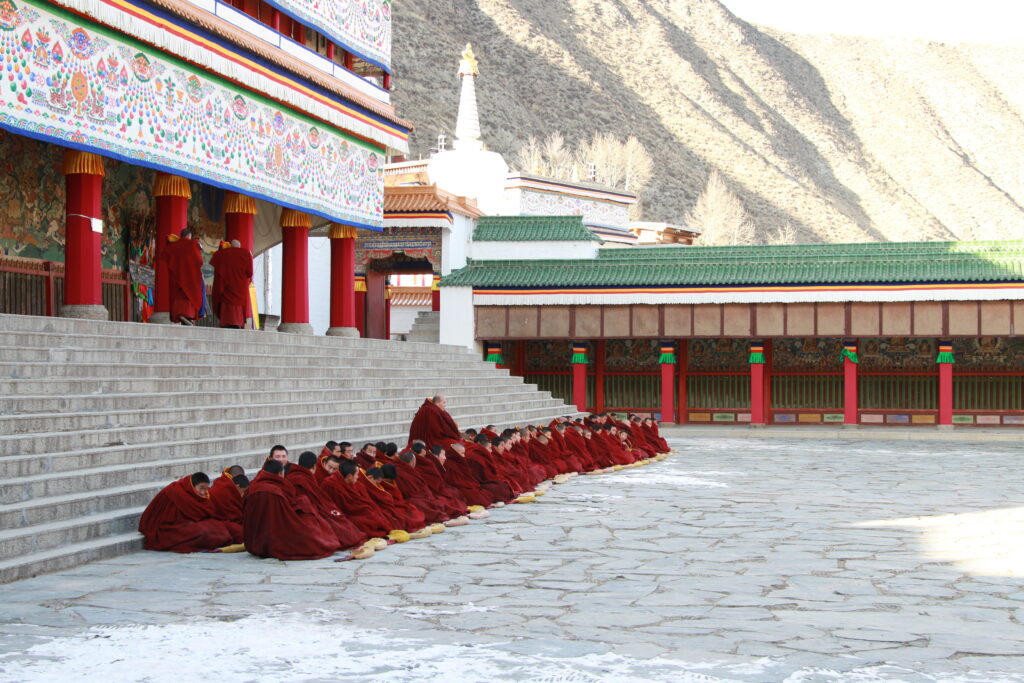
Labrang (also known as Xiahe in Chinese) is a famous Tibetan Buddhist town located in Gansu Province, China, and is home to the Labrang Monastery. This monastery is one of the most important Tibetan Buddhist sites outside the Tibet Autonomous Region and holds a prestigious position among the six major monasteries of the Gelugpa (Yellow Hat sect) school of Tibetan Buddhism. Labrang serves as a vital center for religious study, pilgrimage, and Tibetan culture in the Amdo region, where Tibetans, Hui Muslims, and Han Chinese live in close proximity, creating a unique blend of cultures.
Labrang Monastery
Founded in 1709, Labrang Monastery is one of the largest Tibetan Buddhist monasteries outside of Tibet. The complex includes multiple temples, study halls, dormitories, and stupas, with over a thousand resident monks.
Labrang is known for its extensive prayer wheels, impressive statues, and libraries filled with rare Buddhist scriptures. The monastery holds many festivals and religious ceremonies, including traditional Cham dances and large prayer gatherings. The Monlam (Great Prayer) Festival, which occurs around the Tibetan New Year, is a major event here.
Kora Circuit (Pilgrimage Path)
The Kora is a pilgrimage path that encircles Labrang Monastery, lined with hundreds of large prayer wheels. Tibetan pilgrims and monks regularly walk this circuit while spinning the prayer wheels, chanting, and praying.
Walking the Kora provides a glimpse into Tibetan religious devotion and allows visitors to experience the serene atmosphere of the monastery grounds. Pilgrims perform full-body prostrations along the route, adding a powerful spiritual ambiance to the experience.
Sunning of the Buddha Ceremony
This ritual takes place during the Monlam Festival, usually in February or March. During this event, monks unfurl a massive Thangka (religious painting) depicting the Buddha on a hillside near the monastery, allowing pilgrims to see and worship the image.
Thousands of worshippers gather for this event, touching the Thangka for blessings. Accompanied by traditional music, prayers, and celebrations, the ceremony is a profound and visually stunning display of Tibetan devotion.
Cham Dance Festivals
Labrang Monastery hosts Cham dances during major festivals, including the Monlam Festival. The dances are a form of ritual performance, where monks wear elaborate costumes and masks representing protective deities and spiritual figures.
Cham dances are accompanied by traditional Tibetan instruments and are believed to bring blessings, protect against negative forces, and inspire spiritual awareness. The dances are both visually captivating and spiritually significant, reflecting deep Buddhist symbolism.
Labrang Tibetan Buddhist Institute
Labrang Monastery is a significant academic center, housing one of the largest Tibetan Buddhist institutes in China. Monks undergo rigorous training here, studying a wide range of Buddhist texts, philosophy, and practices.
The institute is renowned for its traditional debate sessions, where monks engage in dynamic discussions about Buddhist teachings. Visitors can sometimes witness these debates, an impressive display of intellectual rigor and spiritual commitment.
Local Tibetan Culture in Xiahe
Xiahe, the town surrounding Labrang Monastery, is predominantly Tibetan, with many shops selling traditional Tibetan handicrafts, Thangkas, and Buddhist souvenirs. The Tibetan community is warm and welcoming, making it easy for visitors to connect with local culture.
A visit to Tibetan homes or tea houses in Xiahe provides an opportunity to experience Tibetan hospitality. You can try butter tea, tsampa (roasted barley flour), and Tibetan yogurt, as well as participate in local life and hear stories from local residents.
Travel Tips for Visiting Labrang
- Best Time to Visit: Spring (April to June) and fall (September to October) offer mild weather, while winter brings the Monlam Festival, though temperatures are much colder. The summer is beautiful, though it can be busy with pilgrims and tourists.
- Altitude Awareness: Labrang is at an altitude of about 3,000 meters (9,800 feet). While not extremely high, it’s wise to acclimate by taking it easy on arrival and staying hydrated.
- Respect Local Customs: When visiting Labrang Monastery, dress modestly, remove hats before entering temples, and avoid photographing inside the temple halls without permission.
- Accommodation Options: Xiahe has a range of guesthouses, Tibetan-style hotels, and modern accommodations. For a unique experience, some Tibetan guesthouses offer homestay experiences where guests can enjoy local culture and cuisine.
Labrang and the surrounding Xiahe area offer a blend of spiritual ambiance, cultural richness, and stunning landscapes. For those interested in Tibetan Buddhism, Tibetan culture, or spiritual travel, Labrang provides a uniquely immersive experience.
 Tibet World Travel Tibet Tour, Tibet Trip, Tibet Travel, Tibet Train, Tibet Trekking,
Tibet World Travel Tibet Tour, Tibet Trip, Tibet Travel, Tibet Train, Tibet Trekking,
